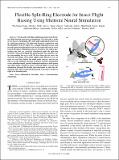Flexible Split-Ring Electrode for Insect Flight Biasing Using Multisite Neural Stimulation
Author(s)
Tsang, Wei Mong; Stone, Alice L.; Aldworth, Zane N.; Hildebrand, John G.; Daniel, Tom L.; Akinwande, Akintunde Ibitayo; Voldman, Joel; ... Show more Show less
DownloadTsang-2010-Flexible Split-Ring Electrode for Insect Flight Biasing Using Multisite Neural Stimulation.pdf (841.0Kb)
PUBLISHER_POLICY
Publisher Policy
Article is made available in accordance with the publisher's policy and may be subject to US copyright law. Please refer to the publisher's site for terms of use.
Terms of use
Metadata
Show full item recordAbstract
We describe a flexible multisite microelectrode for insect flight biasing using neural stimulation. The electrode is made of two layers of polyimide (PI) with gold sandwiched in between in a split-ring geometry. The split-ring design in conjunction with the flexibility of the PI allows for a simple insertion process and provides good attachment between the electrode and ventral nerve cord of the insect. Stimulation sites are located at the ends of protruding tips that are circularly distributed inside the split-ring structure. These protruding tips penetrate into the connective tissue surrounding the nerve cord. We have been able to insert the electrode into pupae of the giant sphinx moth Manduca sexta as early as seven days before the adult moth emerges, and we are able to use the multisite electrode to deliver electrical stimuli that evoke multidirectional, graded abdominal motions in both pupae and adult moths. Finally, in loosely tethered flight, we have used stimulation through the flexible microelectrodes to alter the abdominal angle, thus causing the flying moth to deviate to the left or right of its intended path.
Date issued
2010-07Department
Massachusetts Institute of Technology. Department of Electrical Engineering and Computer Science; Massachusetts Institute of Technology. Research Laboratory of ElectronicsJournal
IEEE Transactions on Biomedical Engineering
Publisher
Institute of Electrical and Electronics Engineers
Citation
Wei Mong Tsang et al. “Flexible Split-Ring Electrode for Insect Flight Biasing Using Multisite Neural Stimulation.” Biomedical Engineering, IEEE Transactions On 57.7 (2010) : 1757-1764. © 2010 IEEE.
Version: Final published version
Other identifiers
INSPEC Accession Number: 11442100
ISSN
0018-9294